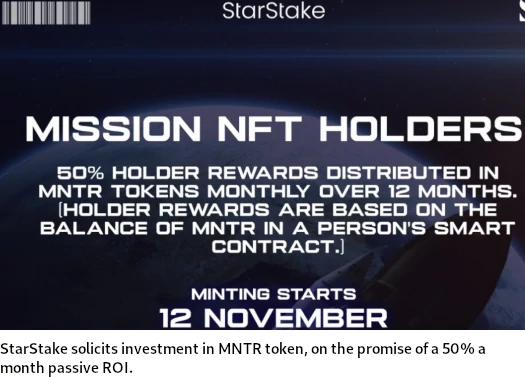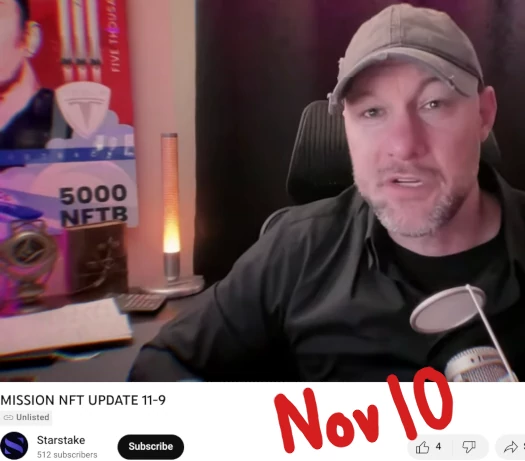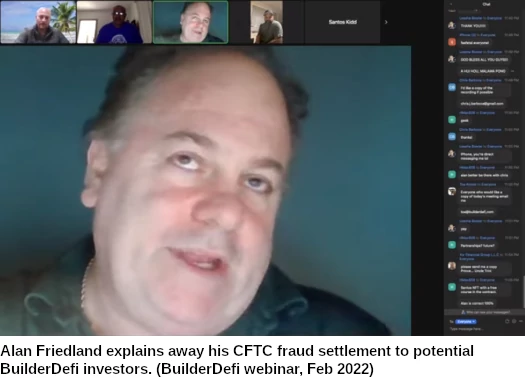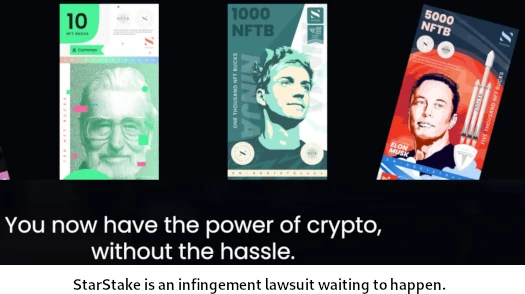NRGY securities fraud continues with StarStake & MNTR
![]() Alan Friedland’s NRGY Ponzi scheme has long since collapsed.
Alan Friedland’s NRGY Ponzi scheme has long since collapsed.
It was the typical Ponzi pump and dump, never recovering from the initial withdrawal theft of funds by early investors.
NRGY investors are now being funneled into StarStake, a failed NFT platform that recently launched a fraudulent investment scheme.
StarStake pitches itself as an “NFT based royalty marketplace.”

I don’t really want to get into the marketplace because the investment side of StarStake has nothing to do with it.
StarStake’s new Ponzi scheme revolves around MNTR tokens/coins (I’m going with tokens).
StarStake affiliates invest $100 a pop. In return they get $100 worth of MNTR tokens and a “Mission” NFT.

Invested in MNTR tokens are locked up for 36 months. Over the first twelve months, StarStake affiliate investors receive 50% of MNTR tokens invested in each month.

50% a month might sounds ridiculous but keep in MNTR tokens are generated out of thin air at little to no cost (I believe MNTR is an ERC-20 shit token).
What isn’t ridiculous is the securities fraud committed as a result of this process, making StarStake a Ponzi scheme.
Early MNTR investors, most of whom are CompCoin and NRGY bagholders, have already been onboarded. They’re receiving 50% of invested MNTR token funds each month, hoping to cash out funds invested by subsequent affiliate investors bagholders.
StarStake has no verifiable external source of revenue, other than new investment. Like NRGY, NRGYGo and BuilderDEFI before it, MNTR is a closed-loop smart-contract Ponzi scheme.
On the MLM side of things, StarStake’s MNTR scheme combines referral commissions with a transaction bonus pool.
StarStake pays referral commissions down two levels of recruitment on MNTR investment (unilevel):
- level 1 (personally recruited affiliates) – 10%
- level 2 – 5%
Affiliates who invest $2500 or more receive shares in a bonus pool, made up of an undisclosed percentage of collected StarStake transaction fees.
That’s it. That’s StarStake’s new MNTR “Mission NFT” Ponzi scheme.
As to how we got here, BehindMLM last checked in on NRGY back in February. Back then Friedland was trying to get BuilderDefi off the ground.
Today SimilarWeb tracks negligible traffic to BuilderDefi’s website; i.e. the third NRGY Ponzi scheme iteration has collapsed.
BuilderDefi promised 5% a week on BuilderToken investment, with the original investment again locked for forty weeks.
Contrast this to StarStake’s MNTR scheme, which pumps the return to 50% a week and extends the initial investment lockout to 36 months (~156 weeks).
While Alan Friedland owns StarStake, his partner in crime Chris Hawk is CEO and face of the scheme.

Speaking on an unlisted StarStake marketing video, Hawk explained the NRGY –> StarStake transition:
[1:44] If you’re an NRGY person, if you were part of the NRGY platform … and you told people about that, we imported the database over to StarStake.
NRGY affiliate genealogies are tied to the wallet NRGY affiliate investors originally signed up with.
From that same video, here’s Hawk’s breakdown of StarStake’s MNTR investment scheme;
[12:44] Those Minter tokens are locked up in the smart contract for you. It’s an investment in a way, because y’know, that’s locked up for three years. Which will fly by.
By the end of three years, we expect this thing, MNTR Coin, will be doing alright.
But remember, you get those 50% rewards every single month. So 50% of the Minter tokens. 50% of the Minter tokens you got at mint, you’ll get dropped every month.
We got people saying they’re going to be buying one hundred at a time, just because of this opportunity.
At time of publication, neither StarStake, Alan Friedland or Chris Hawk are registered with the SEC.
BehindMLM has been tracking NRGY since it first emerged in early 2021. Friedland initially hid his involvement in the scheme, which fell apart after BehindMLM outed him as NRGY’s owner.
The reason Friedland wanted to keep a low profile is he was in the midst of a CFTC commodities fraud lawsuit.
The CFTC went after Friedland for CompCoin and FinTech Investment Group, a Ponzi scheme built around a fictional ART trading bot.
Friedland settled the CFTC’s fraud allegations for $1.8 million in April 2022.

Despite settling one regulatory lawsuit, Friedland’s fraud has continued. StarStake originally launched as part of NRGY in December 2021 (screenshot below is from late 2021).

StarStake flopped, eventually prompting the MNTR investment scheme reboot earlier this month.
All I’ll say about StarStake outside of the MNTR investment scheme is that its an infringement lawsuit waiting to happen.

While BehindMLM isn’t tracking StarStake outside of its fraudulent MLM investment scheme, YouTuber No Pants Profits covers StarStake in greater detail if you’re interested.
After Mission NFT investment runs dry, Hawk has signalled plans to launch additional investment schemes as StarStake NFT “series”.
As of November 16th, Hawk claims around $630,000 has been invested into MNTR.

Under US law, StarStake’s MNTR passive investment scheme constitutes a security. This shifts regulatory jurisdiction from the CFTC to the SEC, and potentially the DOJ if wire fraud and money laundering charges come into play.
Whether US authorities take further action against Friedland remains to be seen.
Update 17th November 2022 – No Pants Profits advises he has received death threats from promoter Duane Noble following publication of this article.
Update 8th March 2025 – The cited unlisted StarStake marketing video has been marked private.
This article originally contained a link to the video. Owing to the video being marked private I’ve disabled the previously accessible link.


LOVE you OZ! Let The comments Commence! Yes This Really Is No Pants Profits and I made a Whole Playlist On These FOOLS!Anyone in the comments been sued yet?
youtube.com/playlist?list=PL4gT60cfT2mMteLND1ISVvvfHCq2zAP-p
Duane Noble AKA Byron Sneeringer Still making Excuses For These Clowns Too! I never deleted his comments…. I welcome him to make himself look like a fool!
Since you’re the one doing videos about us, we’re obviously living in YOUR head rent-free! 😉 You had it backwards. You’re the one making videos about us. We’re not making them about you 😉
But while we’re at it, I actually gave you the facts in the comments on your other videos (most of which you deleted or hid), which you refuse to acknowledge because you’re nothing more than a critic wanting to criticize regardless of the facts.
I even CALLED you on the phone and left a message offering for you to call me back so we could have a discussion, but you’d rather waste almost 2 hours of your life to make a video talking trash. Bhahahahaha!… How pathetic do you have to be?
The facts really don’t interest you. You’re only looking to get exposure to your YouTube channel at others’ expense. Why don’t you tell the people that? #FACTS
P.S. Have fun with us living in your head rent-free. I can’t wait to see how much time you waste with your next.
Oh you’re here. Hey and thanks for the tipoff.
Is there anything in the Q&A worth adding? I wanted to get this out because it’s holding up a bunch of other stuff and then saw the new StarStake Q&A vid (which you’ve also covered today).
Was going to sit through it over a late breakfast.
OZ… the Graphic Novel Section is AMAZING! They legit made Smut Porn For The Blockchain….Considering making it a video on its own! 48 minutes in…you will DIE of laughter!
Its also worth a watch because they ADMIT it’s a security and did not need the art work at all….. 14 Minutes and 30 seconds in….. There is some Gold in the WHOLE thing!
Sounds nutso. I’ll get these other articles done then revisit for a followup. Thanks.
Alan Friedland’s NRGY Ponzi scheme has long since collapsed. <- WRONG
It's not a Ponzi scheme at all because no investor funds are actually paying out profits to any token purchasing outside investors. (Ozedit: spam removed)
There are no profits. The only source of revenue is new investor funds.
That’s why NRGY collapsed. That’s why NRGYGO collapsed. That’s why BuilderDEFI collapsed. That why MNTR will collapse.
Sorry for your loss.
I have some questions for ANYONE Involved In Starstake…. here they are! Anyone reading this thread feel free to answer or get in touch and we will make a video. NoPantsProfits At Gmail……
Where do you believe I have misled potential Starstake/NRGY users in my videos?
Is Starstake A Company?
Is there a legitimate LLC Behind Starstake?
Does Starstake itself have any intellectual property (patents/trademarks) filed with the US government?
Does Starstake have a Corporate Tax ID number?
If Starstake is not a company, why do you refer to lawyers many times when talking about it?
Do you have all the rights to likenesses of Celebries (Steve Jobs, Elon Musk, Beatles, JK Rowling, Ninja, Dr. Seuss) used on
your website and other marketing materials?
Do you feel your marketing material is representative of future stars coming to the platform and it was right to sell platform access that way?
How Does Starstake Relate to NRGY and Builder DeFi?
How are Alan Friedland and Duane Noble aka Byron Sneeringer Involved With Starstake (both have past white-collar crime cases they have settled)?
How does NRGY Defi Produce Returns?
How does Starstake Produce Returns?
What other projects You Have Been Involved With In The Past Are Still Profitable?
Why are returns only paid in a CURRENCY (ETH and BTC are legally Currencies In The US) upon referrals and royalties and not staking?
What makes you believe the MISSION NFT Series One Series was NOT a Security or ICO?
How does the Howey test NOT apply to your offering?
What past projects have you been involved with that have failed and why?
What Crypto scams have you helped others avoid in the past?
Do you believe projects like this can survive if Bitcoin and Etherium Fail?
Do you expect the price of MNTR tokens to fall when you create 50% more of them out of thin air? If not how will to 50% return be Created?
Would you be open to an SEC legality review (by a certified accountant at my expense) before converting users/investors coins from ETH To MNTR Tokens?
Sat through the StarStake Nov 16th Q&A. No separate article but I’ll run through the highlights below.
Early on Tariq EQ Amawi gives away the game:
“Asset backing” is the investment scheme described above.
There’s also some StarStake game coming out. Thankfully Hawk and Amawi don’t bang on about tHe MeTaVeRse, but it’s definitely a “rose by any other name” scenario.
Absolute cringe at ~[25:00] by way of crypto bro fan fiction (they’re trying to give StarStake a high fantasy back story).
Wankwankwank, you get the idea. Basically we have “the elders” standing in for god and blockchain is the second coming of Christ.
To wrap things up, Amawi concludes the call with “chosen people” themeology.
…StarStake is an MLM crypto fraudulent investment scheme. The wank from these two is incredible.
youtube.com/watch?v=LZaKB0eZmVE
Oz hit the nail on the head right there…. also in the background, they know this grift is over and they are trying to get people back in NRGY at a “new lower price”.
Of interest as well, on a call today they admitted MNTR tokens were just NRGYGO By another name! I’ll get that video to you soon!
Also just for the SEO (search engine optimization) to pick it up more…. Duane Noble’s Real Name Is Byron Sneeringer!
Just for fun I did a search on Website Traffic and nrgydefi.com has no data available and builderdefi.com showed 151 visits.
I thought this was the future of Defi! How can this be? StarStake is the Holy Grail of the future!!
Come on Hawk, Duane, Alan and Tariq you have to do better pimping this.